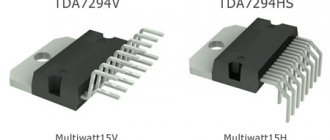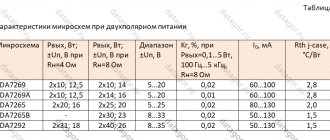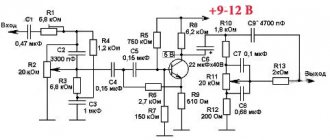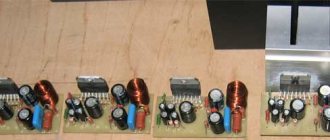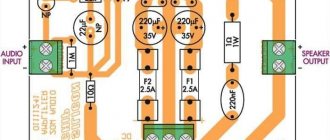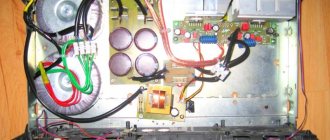If you need to make a simple but quite powerful UMZCH, the TDA2040 or TDA2050 microcircuit will be the best and inexpensive solution. This small stereo AF amplifier is built on the basis of two well-known TDA2030A microcircuits. Compared to the classic connection, this circuit has improved power filtering and optimized PCB layout. After adding any preamp and power supply, the design is ideal for making a homemade home audio power amplifier, approximately 15 W (each channel). The project is based on the TDA2030A, but you can use the TDA2040 or TDA2050, thereby increasing the output power by one and a half times. The amplifier is suitable for speakers with an impedance of 8 or 4 ohms. The advantage of the design is that it does not require bipolar power supply, like most more serious LF amplifiers. The circuit has good parameters, ease of startup and reliable operation.
Schematic diagram of the ULF
Amplifier 2x15W TDA2030 – stereo circuit
TDA2030A allows you to solder a low-frequency amplifier of class AB. The microcircuit provides a large output current, while being characterized by low signal distortion. There is built-in short circuit protection, which automatically limits the power to a safe value, as well as thermal protection traditional for such devices. The circuit consists of two identical channels, the operation of one of which is described below.
Technical specifications
The technical characteristics of the TDA7294 allow you to obtain a maximum power of up to 100 W, with a load circuit resistance of 4 to 8 ohms. This is facilitated by field-effect transistors installed in its preliminary and output stages. The device is famous for its low level of intrinsic distortion and noise, and operates in a wide range of frequencies and supply voltages.
Maximum parameters
Let's consider the maximum values of the maximum permissible operating modes of the TDA7294:
- supply voltage (without signal) VS = ± 50 V;
- peak output current IO = 10 A;
- power dissipation (at Tcase=70 OS) Ptot = 50 W;
- operating temperature range from 0 to 70 °C;
- temperature: crystal Tj up to +150 °C; when stored up to +150 °C.
It is worth considering that the 50 V supplied to the microcircuit is critical and can damage it. Therefore, you should not experiment with such values if you do not want to burn the device. The optimal voltage for a load of 4 ohms is considered to be ±27 V, and for 8 ohms no more than ±35 V.
For use at power levels greater than 10 W, a heatsink must be provided. If you don’t bother with calculations, you can take it from an old computer power supply. In any case, the larger it is, the better. You need to install it through a mica gasket. Additionally, you can install a fan, providing an air outlet.
Separately, it is necessary to say about the choice of voltage source. For the device to produce the stated 100 W for music playback, a power supply with a power of 110 W or more will be sufficient. On many forums it is advised to take a reserve of 250 watts. With such a power supply, this TDA can also cope with a pure sinusoidal signal.
Electrical parameters
The values of the TDA7294 electrical parameters were obtained by the manufacturer under the following measurement modes: supply voltage VS = ± 35 V, load resistance RL = 8 Ohm, air temperature Tamb = 25 °C, operating frequency f = 1 kHz. They are valid if no other values are indicated in the “conditions” column.
The principle of operation of the amplifier on TDA2030
Resistors R1 (100k), R2 (100k) and R3 (100k) serve to create a virtual zero for amplifier U1 (TDA2030A), and capacitor C1 (22uF/35V) filters this voltage. Capacitor C2 (2.2 uF/35V) cuts off the DC component - prevents DC voltage from entering the input of the amplifier microcircuit through the linear input.
Elements R4 (4.7k), R5 (100k) and C4 (2.2 uF/35V) operate in a negative feedback loop and have the task of forming the frequency response of the amplifier. Resistors R4 and R5 determine the gain level, while C4 provides unity gain for the DC component.
Useful: Charger for calcium batteries
Resistor R6 (1R) together with capacitor C6 (100nF) work in a system that forms the frequency response characteristic at the output. Capacitor C7 (2200uF/35V) prevents DC current from passing through the speaker (passing the AC audio signal of the music).
Diodes D1 and D2 prevent dangerous reverse polarity voltages from occurring in the speaker coil and damaging the chip. Capacitors C3 (100nF) and C5 (1000uF/35V) filter the supply voltage.
Bridge connection
The bridge circuit allows you to achieve up to 120 W output. To implement it, you will need two microcircuits and only in cases where the load is 8 or 16 ohms. With less resistance, due to high currents, the TDA may overheat and fail. It represents a design solution from the two standard ones discussed above. In this case, the loudspeaker is connected between the outputs (pin 14) of the microcircuits. The optimal supply voltage for such an assembly is at least 35 V. The input of one of the amplifiers (pin 3) must be connected to ground.
Here it is necessary to have a feedback resistor (22 kOhm) between pins 14 and 2, the first and second microcircuits, respectively. If this is not done, the amplifier will not work.
To turn on the amplifier, at least 5 V must be supplied to pins 10 (Mute) and 9 (StandBuy).
ULF printed circuit board
Printed circuit board ULF TDA2030
You can see the printed circuit board in the photographs. with drawings can be in the archive (without registration). As for assembly, it’s convenient to first solder two jumpers on the power buses. If possible, you should use a thicker wire, rather than a thin resistor leg, as is often the case. If the amplifier will operate with 8 Ohm speakers, and not 4 Ohms, capacitors C7 and C14 (2200uF/35V) can have a value of 1000uF.
You should definitely screw radiators or one common radiator onto the flanges, remembering that the housings of the TDA2030A microcircuits are internally connected to ground.
You can successfully use TDA2040 or TDA2050 microcircuits on a printed circuit board without any pinout changes. The board was designed so that it could be cut if necessary at the location indicated by the dotted line, and only one half of the amplifier with the U1 chip could be used. In place of connectors AR2 (TB2-5) and AR3 (TB2-5), you can solder wires directly if the audio connectors are fixed to the amplifier body.
Amplifier printed circuit board ready with parts arrangement
Analogs
Which chip is better for the tda7294 or tda7293 audio amplifier? This question comes up often when searching for analogues, since these two TDAs can be called interchangeable (the main condition is that the circuit power supply is no more than 40 V). Their basic parameters are not particularly different.
At the same time, tda7293 has slightly better characteristics in terms of maximum supply voltage and output power. It has improved voltage booster and clip detector functions. The possibility of parallel connection for increased power has been implemented. But, despite these advantages, some radio amateurs consider it more buggy and less reliable to use.
DataSheet for the tda7294 device in pdf format from ST Microelectronics can be downloaded from the link.
Housing and power supply
Take a power supply either with a transformer plus a rectifier, or a ready-made switching one, for example from a laptop. The amplifier must be powered with an unstabilized voltage within the range of 12 – 30 V. The maximum supply voltage is 35 V, which is naturally better not to reach by a couple of volts, you never know.
Making a case from scratch is very troublesome, so the easiest way is to choose a ready-made box (metal, plastic) or even a ready-made case from an electronic device (satellite TV tuner, DVD player).
Parts used
The amplifier is easy to assemble even for beginners and is insensitive to the quality of components. But to obtain the best parameters and the best possible sound, the amplifier must be assembled from high-quality parts. High quality doesn't have to be expensive.
It is better not to use components from an unknown manufacturer: they may have poor parameters. When using such components, the amplifier may work poorly or not work at all.
The list of used parts (BOM List) can be downloaded from the following links:
In Russian:
hi-fi-7294-2020-bom-rus
In English:
hi-fi-7294-2020-bom-eng
Resistors
The amplifier uses inexpensive metal film resistors. All resistors except R9 with a power of 0.125...0.25 W. If the R9 is made in Russia, then a power of 0.5 W is sufficient. If the R9 is not made in Russia, then it is recommended to install an R9 with a power of 1 W. It is more reliable for operation at maximum power or as an instrumentation amplifier.
If you are planning a stereo amplifier or a multi-channel amplifier, then it is advisable to use resistors included in the negative feedback circuit (R2...R5) with an accuracy of 1% or better (more accurate than 0.25% are not needed). In this case, the imbalance in the volume of stereo channels will be minimal. If only resistors with an accuracy of 5% are available, then they should, if possible, be selected with the same resistance in all channels. Other resistors are not critical to the accuracy value.
Resistor R10 is of great importance. This resistor serves to separate the ground in the amplifier. But the input and output lands must not only be separated, but also necessarily connected. If resistor R10 is missing, has poor contact or too much resistance, then the amplifier will not work. Therefore, it is important that this resistor is reliable and of high quality and has the required resistance. This resistor does not need audio quality.
In principle, resistor R10 can be replaced with a jumper.
Ceramic capacitors
Ceramic capacitors C1 and Cx are made from high-quality low-voltage ceramics, with a maximum operating voltage of 50 volts. High-quality ceramics are determined by the temperature coefficient of capacitance (TCC). These capacitors must be TKE class NP0 (NP0), or C0G. Sometimes instead of the number 0 they write the letter O (NGO, NPO) - it’s the same thing. The manufacturer of the capacitors is important. It is better not to use noname capacitors. For example, Murata, Vishay, EPCOS are suitable. You can use Russian-made capacitors.
Selecting the capacitance of capacitors C1 and Cx
Capacitor C1 cuts the high frequencies entering the amplifier input (it forms a low-pass filter), and thereby suppresses high-frequency interference. However, this narrows the operating frequency range of the amplifier in the high frequency region. The capacitance of capacitor C1 is selected based on the resistance value of the volume control and the required cutoff frequency of the low-pass filter (LPF), which forms this capacitor together with resistor R1 and the resistance of the volume control. I offer a choice of one of two frequencies: 50 kHz and 70 kHz.
The cutoff frequency of 50 kHz is selected to provide stronger suppression of possible high-frequency noise coming into the input.
The sources of such interference can be both communication equipment (mobile devices, Wi-Fi and Bluetooth, radio communications, television), and other industrial and household devices.
But high-frequency interference arises not only from interference from radio communication systems. Ultrasound may be coming to the amplifier input from the CD player (more precisely, its DAC) - the sampling frequency is not sufficiently filtered. Or, for example, from a vinyl record player - where ultrasound is generated when the pickup stylus moves along the groove of the record.
If you are sure that there is no high-frequency interference, then the cutoff frequency of the input filter can be set to 70 kHz. In this case, the amplifier can have a maximum operating frequency of approximately 50 kHz.
By selecting an input filter cutoff frequency of 50 kHz, the amplifier can have a maximum operating frequency of approximately 40 kHz.
The capacitance values of capacitor C1 depending on the resistance value of the volume control and the required cutoff frequency of the input filter.
| Volume control resistance, kOhm | Capacitance of capacitor C1 required to obtain the cutoff frequency of the input filter 50 kHz, pF | Capacitance of capacitor C1 required to obtain the cutoff frequency of the input filter 70 kHz, pF |
| There is no volume control at the amplifier input: a preamplifier is used or the volume is controlled by the computer sound card | 2200 | 1500 |
| 5 | 1200 | 820 |
| 10 | 820 | 560 |
| 20 | 510 | 360 |
| 30 | 360 | 240 |
| 50 | 220 | 160 |
| 100 | 120 | 82 |
Capacitor Cx performs several functions simultaneously:
- — improves the stability of the amplifier;
- — increases the depth of negative feedback (NFB) at high frequencies and reduces distortion;
- — at high frequencies it boosts the signal in the OOS circuit, which virtually eliminates the possibility of dynamic distortion.
Capacitor Cx, like C1, reduces the upper cutoff frequency of the amplifier.
Both capacitors operate at frequencies above 20 kHz, so they have virtually no effect on the reproduction of high audio frequencies. The combined use of these capacitors results in no dynamic distortion occurring in the amplifier at all. However, some people want an amplifier with a frequency range of up to 40...50 kHz. This is their right, despite the fact that most people cannot hear signals above 20 kHz (a small study on this topic was published in the article Studying the Upper Limit of Hearing). In addition, the influence of any filters on the frequency response occurs smoothly, so even if the upper limit frequency of the amplifier is 50 kHz, at a frequency of 20 kHz the amplitude-frequency response (AFC) of the amplifier has a block, albeit microscopic.
Selecting the capacitance value of the capacitor Cx.
Option 1. The cutoff frequency of the input low-pass filter is 70 kHz.
| Capacitor capacity Cx, pF | Upper limit frequency of the amplifier at the level of -3 dB, kHz | Amplifier frequency response at 20 kHz, dB |
| 47 | 54 | 0,5 |
| 56 | 50 | 0,6 |
| 68 | 46 | 0,65 |
| 75 | 44 | 0,7 |
| 82 | 42 | 0,8 |
Option 2. The cutoff frequency of the input low-pass filter is 50 kHz.
| Capacitor capacity Cx, pF | Upper limit frequency of the amplifier at the level of -3 dB, kHz | Amplifier frequency response at 20 kHz, dB |
| 47 | 42 | 0,8 |
| 56 | 40 | 0,9 |
| 68 | 37 | 1 |
A frequency response rolloff at a frequency of 20 kHz of 0.8 dB, and even more so 1 dB may seem too large. But in reality it is invisible:
- it is below the hearing sensitivity threshold at this frequency,
- at a frequency of 20 kHz there is practically no sound,
- not all people hear this frequency
In fact, the capacitance of these capacitors may differ slightly from the specified value. A change in the capacitance of the frequency-setting capacitors by 10...20% will not be noticeable. But if you change the capacitance of these capacitors, then it is still better to expand the frequency response: increase C1, and decrease C2 and Cx.
Film capacitors
Capacitors C2, C4, C6, C7, C9 are lavsan film (other names for dielectric are mylar, polyester, MKT).
The most important capacitor for sound is C2. It must be of good quality. In this place, you can use a capacitor with a polypropylene dielectric (MKP). You most likely won't notice any difference in sound, but you'll still be pleased that you did your best to get high quality sound.
In fact, to get good sound, it is much more important to use the correct power supply and the correct installation of the amplifier blocks inside the case. But in any case, capacitor C2 should not be bad.
Capacitor C6 has the least effect on sound quality. In principle, it can even be excluded from the scheme. However, even in this place it is not recommended to use a bad capacitor.
Capacitor C4 improves the stability of the amplifier. Its maximum operating voltage can be up to 250 volts. If there is a choice, then it is recommended to choose the largest size of all available capacitors, but such that it can be normally installed on the board. When the amplifier is operating, a relatively large high-frequency current passes through this capacitor, and the capacitor can heat up. The larger the capacitor, the less heat it generates. Be reasonable! The capacitor size of 7.5 mm is quite sufficient!
Capacitors C7 and C9 help capacitors C8 and C10 supply power to the amplifier at high frequencies. The capacity of these capacitors is 2.2...4.7 μF, the maximum operating voltage is at least 63 volts. Capacitors must be of high quality to work well. The larger the capacity the better, but be smart. It is important that the length of the leads of these capacitors is minimal - the inductance of long leads will interfere with their operation. Therefore, a smaller capacitor with short leads will perform better than a larger capacitor with long leads.
"Green" capacitors can be used in positions C4 and C6.
Good capacitors don't have to be expensive. Moreover, it is better to use “regular” capacitors from a well-known manufacturer than capacitors from an unknown one.
Selecting the capacitance of capacitor C2
The capacitance value of capacitor C2 determines both the lower limiting frequency of the amplifier and the roll-off of the amplifier’s frequency response at low frequencies. This capacitor, together with the input impedance of the amplifier, forms a high-pass filter (HPF), passing frequencies above 10...25 Hz and suppressing frequencies below this value.
What the amplitude-frequency response looks like in the low-frequency region at different values of the capacitance of capacitor C2 is shown in the figure (high frequencies in this figure are shown conventionally).
Frequency response of the amplifier at different values of C2.
Amplifier parameters depending on the capacitance of capacitor C2.
| Capacitance of capacitor C2, µF | Lower limit frequency of the amplifier at the level of -3 dB, Hz | Amplifier frequency response at 20 Hz, dB | Amplifier frequency response at 25 Hz, dB | Amplifier frequency response at 30 Hz, dB |
| 0,22 | 22 | 3,3 | 2,5 | 1,8 |
| 0,33 | 14 | 1,8 | 1,3 | 0,9 |
| 0,47 | 10 | 0,9 | 0,6 | 0,5 |
| 0,68 | 7 | 0,5 | 0,3 | 0,2 |
| 1,0 | 5 | 0,2 | 0,2 | 0,1 |
| 1,5 | 3 | 0,1 | 0,1 | 0,05 |
Strategy for choosing the capacitance value of capacitor C2
The larger the capacitance C2, the lower the lower cutoff frequency of the amplifier (that is, the amplifier amplifies lower frequencies quite strongly), and the smaller the frequency response rolloff at low audio frequencies.
But to say that the larger the C2 capacity, the better the low frequencies are reproduced, it will be incorrect.
Indeed, if the frequency response of your speakers starts at 40 Hz, then everything that happens below 30 Hz should not bother you.
It would be more correct to say this: if the capacitance of capacitor C2 is less than a certain value, then the volume of the lowest frequencies in the audio range will decrease. For example, if C2 = 0.68 μF, then the frequency response rolloff at a frequency of 20 Hz is 0.5 dB - this is much less than the hearing sensitivity limit at this frequency, so we probably won’t hear such a rollover. In this case, the amplifier reproduces frequencies starting from 7 hertz. If the capacitance of capacitor C2 is reduced to 0.1 μF, then the volume at the very, very low frequencies will decrease slightly. We will notice this only with a very good soundtrack and excellent speakers. And then only during comparative listening. But let's notice!
Are such low frequencies necessary?
They say that if the amplifier reproduces absolutely all low frequencies, starting with constant voltage, then this improves the sound. They even talk about the constant component of sound. These are all advertising and marketing gimmicks that have nothing to do with reality.
The constant component of sound is atmospheric pressure, and no speaker can change it. And infrasound frequencies, which can reach the amplifier output and be reproduced by speakers, are harmful to humans. For example, infrasound frequencies that coincide with the frequency of the alpha rhythm of the brain (frequencies 7 ... 15 Hz) can cause headaches, disorientation and even panic.
A large number of infrasound frequencies are generated when playing vinyl records. Especially old ones: warped and eccentric. But even when playing new gramophone records, infrasound still occurs: it is created both by the player’s engine (rumble) and by the physical processes of friction of the stylus in the groove. Douglas Self wrote about this in detail in his book Electronics for Vinyl.
Fortunately, most speakers at these frequencies cannot create significant sound pressure, but it is better if these frequencies are cut off in the amplifier.
Another reason for refusing to reproduce very low frequencies is the physical processes in the loudspeakers. For equal volume as the frequency decreases, the diffuser stroke increases in proportion to the second power. That is, if the frequency is halved, the diffuser stroke should increase 4 times. In fact, the cone stroke increases even more due to a decrease in hearing sensitivity at the lowest frequencies. But the linear range of the loudspeaker is limited, so significant low frequencies can overload the loudspeaker, and the entire sound will be distorted.
Speakers with a bass reflex (PI) are especially susceptible to this phenomenon - at frequencies below the PI tuning frequency, the diffuser stroke is not limited in any way. In this case, the speaker practically does not emit sound, since an acoustic short circuit occurs: the sound emitted by the loudspeaker and the sound emitted by the bass reflex are subtracted from each other almost to zero.
The result is that there is no audible overload and the sound is poor. So from this point of view, limiting the reproduction of very low frequencies has a positive effect on the operation of the entire system, on sound quality and on human perception of sound.
On the other hand, the higher the cutoff frequency of the amplifier, the worse the transient processes when reproducing a low-frequency musical signal (not indefinitely, but up to certain limits). The bass, especially in bass reflex speakers, tends to be a little tighter.
So from this point of view, it is also undesirable to greatly increase the lower cutoff frequency of the amplifier.
What to do?
The output is this: the cutoff frequency of the high-pass filter formed by capacitor C2 should be 2...3 times less than the lower operating frequency of the speakers connected to this amplifier. But not lower than 10 Hz. And don’t be afraid of blocking the frequency response at low frequencies! A rollover of 1 dB at frequencies below 30 Hz is not noticeable by ear.
Personally, I most often use capacitor C2 with a capacity of 0.33 μF, and less often with a capacity of 0.47 μF.
To select the capacitance of capacitor C2, use this table.
| Amplifier purpose | Capacitance of capacitor C2, µF |
| Speakers of average quality with a lower operating frequency of 50...80 Hz. Especially recommended for vinyl playback | 0,22 |
| Higher quality speakers with a lower operating frequency of 30...40 Hz High quality speakers with powerful bass and a lower operating frequency of 20...30 Hz when playing vinyl | 0,33 |
| High-quality speakers with powerful bass and a lower operating frequency of 20…30 Hz. Quality subwoofer for vinyl playback | 0,47 |
| Quality subwoofer when playing vinyl Quality subwoofer | 0,68 |
| High quality subwoofer | 1,0 |
| Subwoofer for maniacs | 1,5 |
For myself and to order (in agreement with customers after studying their requirements and their equipment), I usually make two versions of the amplifier (a pre-amplifier with a volume control is used):
- “Standard” with the following set of element values: C1 = 2200 pF (input filter cutoff frequency 50 kHz), Cx = 47 pF, C2 = 0.33 µF polypropylene (MKP) Epcos or K78-19.
- "With extended frequency range." With this set of element values: C1 = 1500 pF (input filter cutoff frequency 70 kHz), Cx = 47 pF, C2 = 0.47 µF polypropylene (MKP) Epcos or K78-19.
The amplitude-frequency characteristics of these two amplifier options are shown in the figure.
Electrolytic capacitors
Positions C3 and C5 should contain regular high-quality capacitors. Capacitor C3 sets the turn-on time of the amplifier and does not affect the sound. But if it is of poor quality or has a large leak, then the amplifier may not turn on. With a poor-quality capacitor C5, the maximum undistorted output power is much less than it could be.
Capacitors C8 and C10 perform three functions at once:
- Additionally, supply voltage ripple is suppressed.
- They feed the amplifier at peak volumes. Capacitors C8 and C10 are installed very close to the chip, and the conductors coming from these capacitors are very short. Therefore, these conductors have very low resistance and inductance. As a result, if necessary, all the energy from these capacitors quickly enters the microcircuit and is transmitted to the output of the loudspeakers.
- They pass loudspeaker current through themselves at medium and high frequencies. As a result, this current is closed through the shortest path.
All these functions are actually combined. Physically this is one function. I separate them mentally to make it easier to analyze them.
The functions of capacitors C8 and C10 are very important, so these capacitors must be of good quality. It is very useful to use Low ESR or Low Impedance capacitors in this position.
However, be reasonable! The importance of the quality of capacitors C8 and C10 is often exaggerated. There is no point in using exotic “magic” supercapacitors. Good capacitors from a reliable manufacturer are quite enough. It is important that these capacitors are properly soldered to the board. Moreover, they have leads of minimal length, which means minimal resistance and inductance.
It is not recommended to use capacitors C8 and C10 with a capacity of less than 1000 µF. It is also not recommended to significantly increase their capacity. You can use capacitors with a capacity of 2200 µF, but with a high-quality power source there will be no difference.
At high frequencies, electrolytic capacitors C8 and C10 are assisted by film capacitors C7 and C9, so these capacitors must also be of good quality.
Power supply for amplifier
The operation of the amplifier is very dependent on the power source. What the amplifier actually does is transfer energy from the power source to the speakers. But it does this under the control of a sound signal. The energy is transferred so that the signal in the speakers is exactly the same as at the amplifier input. How to make a correct and good power supply is described in the article Power supply for TDA7294.
How to properly make an amplifier and power supply to get maximum sound quality is written in these articles:
More information about amplifiers and sound enhancement:
Links given in the article
Amplifier based on TDA7293 / 7294 with T-shaped OOS
Power supply for TDA7294
Amplifier ground sharing
Connecting blocks inside the amplifier
Operation of an amplifier based on the TDA7293 (TDA7294) chip with a “difficult” load
Clip-detector for amplifier on TDA7293
Study of the upper limit of hearing
Information to better understand the operation of the amplifier and get maximum sound quality
Hi-Fi amplifier based on TDA7294 chip
Clipping in an amplifier
Amplifier power supply calculation
Transformer for powering the amplifier
The right straightener
Rectifier for an amplifier or the saga of a fast diode
Separate power supply for stereo amplifier channels
Capacitor array - myths and reality
Mute and StandBy modes in the TDA7294 / TDA7293 chip
↑ The amplifier circuit should be simple and universal
To build the power amplifier, I chose the popular, but personally not my favorite, TDA7294 microcircuit manufactured by SGS-Thomson. The reason for this attitude was frequent failures and the abundance of counterfeit microcircuits. However, it later turned out that my own crooked hands were to blame for the death of the IC, which provided clearly overestimated power and did not ground the radiator. This is a prerequisite for stable operation of the microcircuit. It is afraid of static - it must be isolated from the radiator, and the radiator must be grounded to the middle power point.
Sufficiently long construction and simulation in Multisim 2001 allowed us to create a feedback loop that embodies all these seemingly incompatible requirements.
So, here is a “mad” feedback circuit, MadFeedback1 (MF1) .
Similar materials
- ULF amplifier on TDA1558
- UMZCH with extremely deep environmental protection
- Transistor power amplifier for 144 and 430 MHz bands
- transformerless tube-transistor power amplifier
- Advanced transformerless tube-transistor power amplifier
- Tube amplifier based on EL84
- Push-pull amplifier using 6P13S tubes
- VHF (FM) power amplifier 1.5 W
- Receiver for fox hunting at 80 meters
- Wideband reversing amplifier
| Total comments: |
| Social media |
| Calendar | ||||||
| Mon | W | Wed | Thu | Fri | Sat | Sun |
| 1 | 2 | 3 | 4 | 5 | 6 | 7 |
| 12 | 13 | |||||
| 16 | ||||||
| 25 | ||||||
| 30 |
| Statistics |
| Attendance |
| TAGS |
| Advertising block |
| Radio amateur 2020 |
Operational amplifier circuits
TDA7265 and two inclusion options
There are two options for turning on the microcircuit.
- Large power range (+-25V);
- Bipolar power supply circuit;
- Power 2x25 W
- There is a silent mode and a standby function;
- Thermal protection against overheating during amplifier operation;
- There is short-circuit protection.
Bridge version of the amplifier on TDA7265
Chip characteristics
| Supply voltage Upit | 25 V |
| Output voltage in idle mode | 80 - 130 mV |
| Current consumption in idle mode Ipotr | 65 - 120 mA |
| Bias current at the non-inverting input Ibias | 500 nA |
| Output power Pout | 20 - 25 W |
| Harmonic coefficient Kr | 0,01 — 0,7 % |
| Gain (Open Loop) | 80 dB |
| Input resistance Rin | 15 - 20 kOhm |
| Shutdown temperature | 145 °C |
Limit parameters of the microcircuit
| Supply voltage Upit | 25 V |
| Output peak current | 4.5 A |
| Power dissipation Prass | 30 W |
| Operating temperature Trab | -20…+85 °C |
| Storage temperature Tstore | -40…+150 °C |
